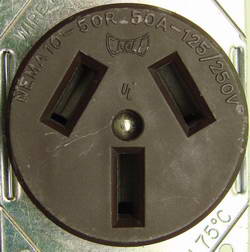|
|
More about Wiring a Range |
|

|
By Dave Rongey
Summary: Electric Range Installation with a typical 240 Volt electric power cord wiring system for 3-wire and 4-wire configurations. © By: Dave Rongey |
How to Wire a Kitchen Range Power Cord
3-Wire Configuration
An electric range can be wired to work with either a 3-wire or 4-wire circuit. All new installations require the 4-wire circuit which has a separate insulated neutral wire and the separate ground wire along with the 2-hot wires.
4-Wire Configuration
In this case where the home is older than the new electric range here's what you would have to do: You need to purchase a 3-Wire Range Cord. Remove the 4-Wire Range Cord and install the replacement 3-Wire Range Cord.
|
Next where the wires are connected to the electric range you will need to re-install the Bonding Jumper which goes between the Grounded Screw and the Neutral Terminal as shown in the 3-WIRE HOOK UP wiring diagram below. The Grounded Screw is attached to the metal frame of the electric range and is usually located under the neutral wire terminal location. |
Electrical Wiring for a Four Terminal Range Cord Connection |
 |
 |
 |
 |
| NEMA 10-50R 50AMP-125/250VOLT | NEMA 14-50 50AMP-125/250VOLT |
|
|
|
More about Wiring a Range |
|
The Safest Way to Test Electrical Devices and Identify Electric Wires!The Non-Contact Electrical TesterThis is a testing tool that I have had in my personal electrical tool pouch for years, and is the first test tool I grab to help identify electrical wiring. It is a Non-contact tester that I use to easily Detect Voltage in Cables, Cords, Circuit Breakers, Lighting Fixtures, Switches, Outlets and Wires. Simply insert the end of the tester into an outlet, lamp socket, or hold the end of the tester against the wire you wish to test. Very handy and easy to use.
The Quickest Way to Check for Faulty Electrical Wiring!The Plug-In Outlet TesterThis is the first tool I grab to troubleshoot a problem with outlet circuit wiring. This popular tester is also used by most inspectors to test for power and check the polarity of circuit wiring. It detects probable improper wiring conditions in standard 110-125 VAC outlets Provides 6 probable wiring conditions that are quick and easy to read for ultimate efficiency Lights indicate if wiring is correct and indicator light chart is included Tests standard 3-wire outlets UL Listed Light indicates if wiring is incorrect Very handy and easy to use.
Strip Off Wire Insulation without Nicking and Damaging the Electric Wire!The Wire Stripper and Wire CutterMy absolute favorite wire stripping tool that I have had in my personal electrical tool pouch for years, and this is the tool I use to safely strip electrical wires. This handy tool has multiple uses: The wire gauges are shown on the side of the tool so you know which slot to use for stripping insulation. The end of the tool can be used to grip and bend wire which is handy for attaching wire onto the screw terminals of switches and outlets.. The wire stripper will work on both solid and stranded wire. This tool is Very Handy and Easy to Use. |
||
Range Parts and AccessoriesRange Cord 240volt Range Outlet 240volt 50amp Range Circuit Breaker 240volt 50amp |